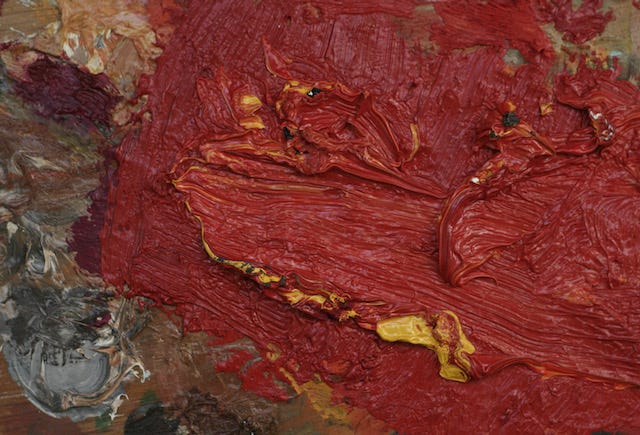What do luxury loungewear, hipster smoothie bars, carpentry, and the Mona Lisa have in common?
Flax seeds.
This is the story of how an ancient cash crop was transformed from an industrial ingredient into a part of every “healthy” pantry.
Flax is “Most Useful”
Flax, aka linseed, was domesticated and widely used in the fertile crescent about 9,000 years ago.
It’s one of the oldest cultivated crops, and its latin name, linum usitatissimum, means “most useful linen”.
Here’s why it was so important.
Flax as Fabric
Also known as linseed, flax was cultivated for its fibers which were woven into linen, the most common plant-based fabric of antiquity, and a luxury fiber today.
Ancient Egyptian priests exclusively wore linen, and they also wrapped mummies in the fabric.
Make no mistake: the first and primary use of flax throughout most of history was for producing linen fabric.
As it turns out, ancient people also found another use for the flax plant: oil from its seeds.
“Oil on Canvas”
If you’ve ever been to an art museum, you’ll know that old paintings were often made from “oil based paint.”
Which oil?
Linseed oil (aka flax seed oil).
Why?
Because linseed oil holds pigment well, and when it dries, forms a hard, durable surface on top of which additional layers of paint can be applied.
It has many other applications, including as furniture polish (varnish), linoleum, and even as concrete sealant.
We can thank linseed oil for all the beautiful figures of late renaissance painting, but not because anyone was eating it.
Death by industry
The industrial era spelled bad news for flax.
Linen fabric is more expensive and harder to clean than cotton or polyester, and petroleum can do almost everything that linseed oil can do, but cheaper.
(Although the best oil-based paints are still made with linseed oil)
By 1990, its fate, like that of many traditional artisanal products, seemed sealed: there were very few uses for linseed left, and all of them were industrial.
Reviving a dead industry
So what is an industrialist with large linseed plantation holdings to do? Just cut their losses and let the industry die?
Instead, they took one out of the aluminum industry’s playbook and instead marketed it as a health food.
So how do you turn something that was “unsuitable as a commercially viable edible oil” because it metabolizes into “toxic and semi-toxic products” in 1990, into a product “known for its many health benefits” in 2022?
Easy.
Give it a quick name-change (from linseed to flax seed):
Buy a chapter or two promoting it in alternative medicine textbooks:

And voila, 30 years later, the global flax industry is growing at ~13% per year.
No longer an industrial chemical, it is now an edible oil. And a heart healthy one at that!
Why it’s bad
Drying Oil
What makes a good paint? It needs to hold pigment, apply smoothly, and at some point, it needs to dry.
As it were, there are a certain class of oils called drying oils because they harden into plastic on exposure to oxygen.
And guess which oil is the archetypal drying oil?
That’s right, linseed/flaxseed oil.
This drying process is accelerated by heat, and guess what your body is full of?
Oxygen and heat.
This property of hardening on exposure to air is why it’s used in paint and wood varnish, and why people use it to season their cast iron pans: it hardens into a tough, waterproof surface.
The reason is that flax seed oil is very high in the omega-3 fatty acid called ALA, which is the part that makes it a drying oil (check out my article on omega-3s for an explanation of this chemistry).
It’s not food
Given that we’ve grown flax for thousands of years, you’d think someone at some point would have tried to eat it. And if it had been good, they might have started using it for food instead of making paint.
In case you’re still not convinced, this review of the flax industry from 1990 puts it bluntly:
“Unfortunately, the same component of [flax] oil that makes it such a good drying oil, linolenic acid [ALA], also makes it unsuitable as an edible oil”
People implicitly know this— that’s why flax seed oil is always sold in the refrigerated section, and people tell you to grind up the flax just before you eat it to prevent rancidity.
Little did they think though that the oxidation that causes it to go bad will happen in your body anyway, regardless of how “fresh” it was when you ate it.
Do you really think it’s a good idea to eat an oil that will harden into plastic inside your body?
Cellulite will be the least of your concerns.
A sad health trend
This is one of those food trends that is doubly sad because not only is it very toxic, flax seeds don’t even taste good.
At least a donuts are delicious. Yet flax seeds are even more unhealthy, and they taste like rotten fish and get stuck in your teeth after eating an acai bowl.
Such a waste.
Conclusion
Flax seed oil is actually oil based paint, and turns into plastic inside your body
Flax has been grown for thousands of years, but never used as human food
Stop eating them and anything made with or from them. Chia seeds are the same.
For good fats and protein, eat eggs instead
If you’ve been eating it, it’s important to get its residues out of your body. Follow this guide.













Intersting... I don't remember his name anymore, but there was a health influencer that was known for trying 'cutting edge' experiments on himself. If I recall correctly, he had a heart attack while out for a jog. His experiment at the time was eating massive amounts of flax. Tim Ferris talked about it on his podcast, and I believe Angelo Coppola talked about him on his podcast, too.
Flax is also touted for it's ability to produce Mother's Milk. I doubt it actually does that. It didn't work for my wife.